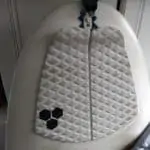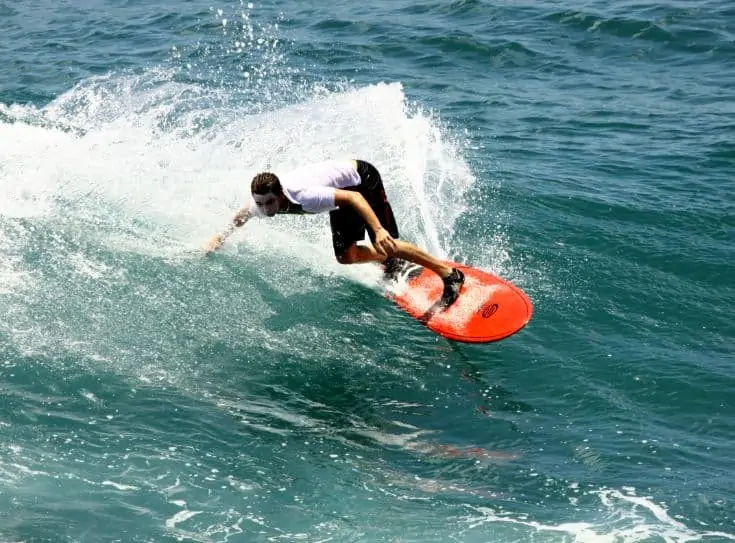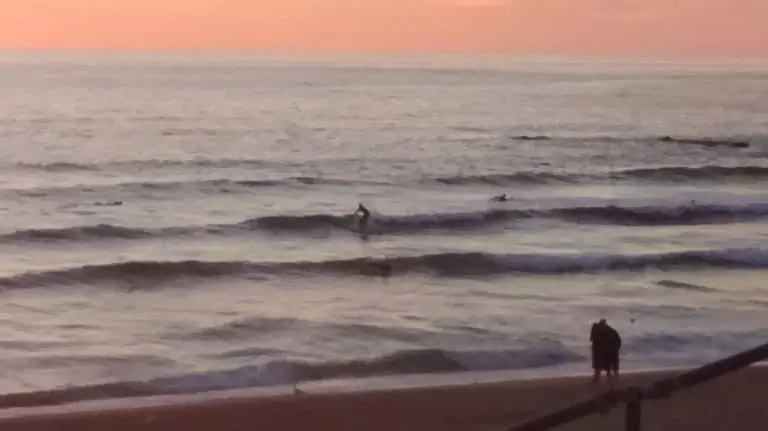Pressure Dings on Surfboards
Pressure dings are common on surfboards and they are the indentations or depressions left from frequent use of a surfboard. They happen over time and are a normal thing to see, although they are most common in traditional polyurethane (PU) fiberglass surfboards.
Modern surfboards made from different constructions are more durable and so pressure dings are becoming less of a problem with today’s boards.

You will still see plenty of the traditional fiberglass PU boards on the market with pressure dings, however, so it’s best to know what causes them, how to avoid them (or avoid making them worse), what can be done about them, and what impact these pressure dings have on your surfboard and surfing.
Causes of Pressure Dings on Surfboards
Using a knee to duck dive under waves or using your knee while popping up to your feet and falling heavily on your board while riding are the main causes of pressure dings on surfboards.
Duck Diving and Surfboard Pressure Dings
To go under a wave, a surfer needs to push their board under the surface of the water to avoid the impact of the oncoming whitewater – this is always done by first submerging the front of the board with both hands but you can choose to then push with the knee or the foot.
Duck diving with your knee is easier but leads to pressure dings in the middle of your board, just off the center line or ‘stringer’.
More advanced surfers will duck dive with their foot as it is better for the board (especially if you have a rear traction pad) as you go deeper and your foot is much gentler on the board, with much less chance of getting a pressure ding from duck diving this way.
Using Your Knees to Pop Up Causes Pressure Dings on Your Surfboard, Too
Most learner surfers will try to pop up by using one knee as a support along the way. This, although completely normal, has the negative effect of damaging your surfboard by causing pressure dings.
Popping up and using your knees means pressure dings since you will be putting almost all of your weight on your knee, which will then push through the surface of your board, leaving the dents or impressions of a pressure ding.
See more tips on surfing pop-ups here on the blog or from excellent surf teacher, Kale Brock, on YouTube below.
Falling Heavily on Your Board While Riding
Learner surfers often find it hard to fall off a board properly as they don’t yet know when the board is going from under their feet. This means that, when they do fall, they can sometimes slam the board quite hard on the way down.
Not only is this painful but it can also leave pressure dings and dents on the board as a result of the impact.
With more advanced surfing, surfers might also start doing maneuvers like a floater (riding along the lip and falling down with it) or aerial maneuvers, which really add to the wear and tear of a board over time.
These maneuvers mean that all of the weight of the rider is coming down hard on the board, often from a great height, and although it won’t break the board most of the time, it can leave deep impressions or ‘foot wells’ from where the rider’s feet were positioned at the time.
Big Waves Can Also Cause Pressure Dings
In addition to all of the above points, big waves can cause pressure dings on surfboards as the lip of the wave can land with all its force on the deck of the board and dent it (or break it, if really bad).
The more often a board goes out into bigger waves, the more likely these impacts become, so expect your board to take a few beatings and come out with the battle scars of pressure dings to show for it.
Pressure Dings’ Negative Effects on Surfboards
Pressure dings make surfboards bumpy on the surface which can feel uncomfortable when paddling and also, over time, they can crack the fiberglass around the center line of the board, which is called having a ‘collapsed deck’.
A surfboard with a collapsed deck becomes a problem as the pressure ding pushes the surface of the board lower and lower while the stringer, the wood running down the center line of the board, starts to stick up as it doesn’t go down (being wood and all!).
This then eventually causes the fiberglass to crack as the pressure ding becomes so deep that it simply can’t handle the strain anymore, leaving your board with a collapsed deck and in a bad state of repair.
Surfboards with really bad pressure dings can lead to rib pain when surfing, specifically when padding, which is uncomfortable but not a major problem.
Fixing Pressure Dings on Surfboards
It is not easy or cheap to fix pressure dings on surfboards and therefore it is generally better to simply keep using your board until it dies, sell it (at a reduced price) or get a new one.
Most surfboard repair shops will ask for a lot of money to repair pressure dings so don’t expect them to want to do it.
The main problem here is that repairing this kind of ding in a surfboard would involve rebuilding compressed polyurethane foam, which is not easy or cost-effective.
Only Buy Surfboards With Pressure Dings if Light or the Board is Cheap
When I see heavy pressure dings on a surfboard, I think of two things: either the surfer has given the board a beating and it doesn’t have much life left in it or the fiberglass used (or ‘glass job’) is so light that it dings easily and won’t last much longer.
Either way, the board has likely seen better days so my recommendation is only to buy a heavily pressure dinged board if you know it’s a cheap price or if it’s a model you are really keen to try and can’t find elsewhere (and again, it should not be expensive!)
With what you’ve learned from the above points you can haggle with the seller on price and hopefully get a better deal, if you are sure it’s the right surfboard for you, ‘dings and all’!
Next Steps
From here, I’d recommend reading the following articles on the blog to help you progress on your surfing journey





